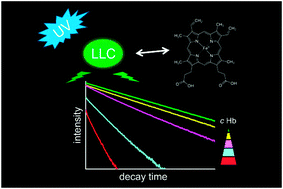Detecting free hemoglobin in blood plasma and serum with luminescent terbium complexes†
Abstract
Hemolysis, the rupturing of red blood cells, can result from numerous medical conditions (in vivo) or occur after collecting blood specimen or extracting plasma and serum out of whole blood (in vitro). In clinical laboratory practice, hemolysis can be a serious problem due to its potential to bias detection of various analytes or biomarkers. Here we present the first “mix-and-measure” method to assess the degree of hemolysis in biosamples using luminescence spectroscopy. Luminescent terbium complexes (LTC) were studied in the presence of free hemoglobin (Hb) as indicators for hemolysis in TRIS-buffer, and in fresh human plasma with absorption, excitation and emission measurements. Our findings indicate dynamic as well as resonance energy transfer (FRET) between the LTC and the porphyrin ligand of hemoglobin. This transfer leads to a decrease in luminescence intensity and decay time even at nanomolar hemoglobin concentrations either in buffer or plasma. Luminescent terbium complexes are very sensitive to free hemoglobin in buffer and blood plasma. Due to the instant change in luminescence properties of the LTC in presence of Hb it is possible to access the concentration of hemoglobin via spectroscopic methods without incubation time or further treatment of the sample thus enabling a rapid and sensitive detection of hemolysis in clinical diagnostics.


 Please wait while we load your content...
Please wait while we load your content...